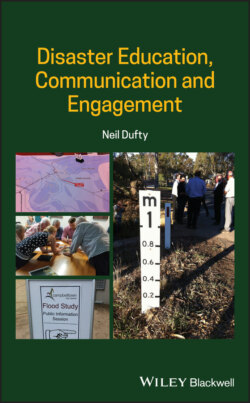Читать книгу Disaster Education, Communication and Engagement - Neil Dufty - Страница 27
2.4 Disaster ECE
ОглавлениеThere is a tendency for emergency agencies and other emergency service organisations to divide disaster learning services into at least community ‘education’, ‘communication’, and ‘engagement’ (Dufty 2013). On the other hand, some agencies use one or some of these terms as all-encompassing titles for their disaster learning services.
The difficulty with the former approach is that there is the risk of a possible disjunct between the messaging and guidance to communities from different sections of the agency, e.g. those doing crisis communication and those doing preparedness education or engagement.
The difficulty with the latter approach is that by calling all community disaster learning one or two of the terms, the specific benefits of the term or terms excluded are not recognised and activated.
This book posits that an integrated Education, Communication, and Engagement (ECE) approach which names the three terms, and uses their independent but combined benefits, is more appropriate for emergency agencies and other emergency service organisations, such as humanitarian organisations. It follows from Dufty (2011) who argues that disaster education and engagement are both required as they provide ‘breadth’ and ‘depth’ to disaster learning. Figure 2.1 graphically shows the Disaster ECE triumvirate that leads to effective disaster learning.
Table 2.1 provides a harmonisation of the three types of community disaster learning described in this chapter. As identified in Table 2.1 by bold type, there are some similarities between aspects of ECE. For example, there is similarity between ‘Inform’ as in the IAP2 Public Participation Spectrum (engagement), ‘one-way’ communication, and information-based informal and incidental education. However, as shown in Table 2.1, there are some outliers where there is no apparent harmonisation across the three types of community disaster learning; nevertheless, these should be included in Disaster ECE.
Figure 2.1 Disaster ECE leading to learning.
Table 2.1 Harmonisation of disaster education, communication, and engagement.
| Education | Communication | Engagement |
| Informal education | One-way communication | Inform |
| Incidental education | Two-way communication | Involve |
| Formal education | Consult | |
| Non-formal education | Collaborate | |
| Empower |
The benefits of a combined Disaster ECE approach, although appearing to be conceptually valid, have only been once directly tested through the literature. The research from Kelly and Ronan (2018) proposed that what may be most effective in disaster preparedness is not education or engagement per se, but a combination of the two. The role of social media was additionally considered in this research, given the proposal (Dufty 2012) that social media provides a good platform for a convergence of engagement and educational influences.
The research tested the education and engagement model for disaster preparedness and found that ‘whilst the model was significant, the variables that added unique predictor ability were individual factors rather than a composite of individual, community, and institutional factors as found in previous research’. Also, ‘disaster preparedness messages can be conveyed either by traditional media or social media. There was no difference in whether actions were taken nor was there any difference in confidence and trust in the types of media. Given the low cost of social media campaigns, pending replication of current findings, consideration should be given to its use over traditional media.’
Further research is required to test the effectiveness of a combined ECE approach by emergency agencies and other organisations. However, the approach is promoted in this book due to its promise in providing cumulative benefits.
